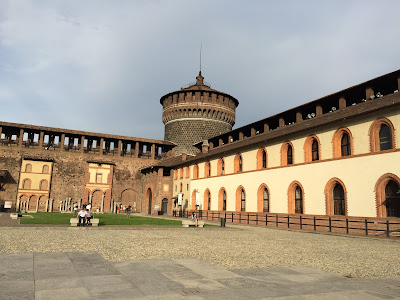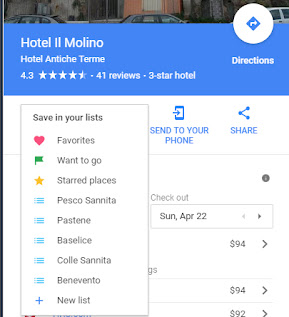Fifteen years ago my husband and I went on a dream-come-true honeymoon. There was only one place in the world I wanted to go. Italy.
 |
| Sforza Castle in Milano, 2015. We'd been here before, but there was more to see. |
He wanted to go, too. So with help from Rick Steves' travel book, we planned a jam-packed site seeing tour. It flowed from Lake Como up north to Sorrento down south.
With the cliffside Hotel Minerva in Sorrento as our base for a few days, we took a day-trip to Pompeii. Did you know you can use Google Street View to "walk" through Pompeii now?
The next day we took a train to the city of Benevento. From there we would figure out how to get to the rural town of Colle Sannita. This was going to be my first time setting foot in the town where my grandfather was born.
I later documented our misadventure getting stranded in a Colle Sannita bank during a power failure.
Two years later we tried it again. We planned out a second tour of Italy that included Milano and the Tuscan town of Cortona. That was the setting of "Under the Tuscan Sun".
But this time I'd made contact with my dad's first cousins in Colle Sannita. My cousin Maria took me from house to house to meet cousins galore. It was everything I'd hoped for!
 |
| Best pizza ever. Made by my cousins. |
Our last stop of the night was the home of Libera, my grandfather's first cousin. He left for America the year she was born. But she, and everyone I met, knew who my grandfather and my American-born father were.
The next day we visited Libera's daughter and two grandchildren. Each owns a restaurant in Benevento. Her grandson and I had a long conversation about our shared ancestors, the Pilla family.
I can't imagine a more enjoyable, welcoming group of relatives—many of whom had no idea their American cousin was coming to visit that day.
My husband and I took trip in 2015 that included some time in northern Italy: Cinque Terre and Milano. After an unforgettable week in France, we experienced one of Italy's infamous train strikes. We left France and were stuck on an Italian train platform with tourists from around the world.
It was another adventure. Some extra time and extra money, but hey. We experienced an Italian train strike.
So here we are in 2018. Planning our fourth trip to my beloved ancestral Italy. This visit will begin and end in Rome, and include a second stay in one of our favorite places—Siena.
But the main focus of this trip is my cousins and all four of my ancestral hometowns. I want to visit all the cemeteries again. I want to go into the churches where priests baptized and married my ancestors. I want to walk past their former homes and spend time in the piazzas.
If my grandfathers and my grandmothers' parents hadn't emigrated to America, I would be an Italian.
On this trip, I want to get a taste of what the Italian version of me might have been like. I'll let you know what I find out.











